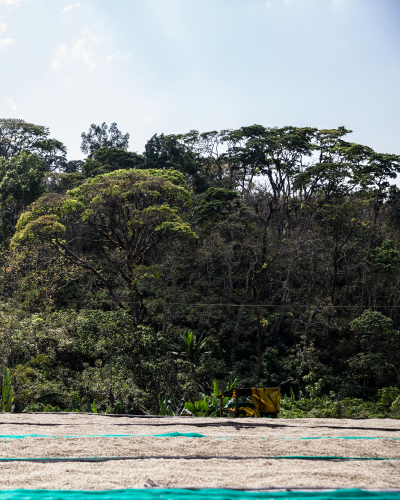
Anfilloo: a rich, ancient terroir
If we love this region so much, it's of course because of our attachment to its coffees and producers, but also because of the potential of this veritable human heritage. To better understand the importance of Anfilloo, here's the story of the birthplace of Arabica.
Anfilloo, the birthplace of Arabica
Anfilloo is part of the coffee forest of western and south-western Ethiopia. In the past, this forest linked the present-day regions of Wallagga, Illubabor, Jimma and Kaffa, continuing south to the present-day border with Sudan.
This area is the birthplace of Arabica, where numerous wild forests still exist today. The populations of these regions have a long-standing relationship with the high altitude rainforest, and particularly with coffee, which occupies a central place in this complex.
The Anfilloo coffee forest offers interesting features and a rich diversity of altitudes, soils and microclimates. Last but not least, it has a long history of coffee-growing.
Waabaa: the pioneers of coffee growing in Anfilloo
The history of coffee growing began in Anfilloo thirteen generations ago. Considering that one generation corresponds to thirty years, this gives us a history of around four hundred years.
The founder of coffee growing is said to be a certain Godii. This man is said to have come from the present-day Jimma or Kaffa region. According to oral tradition, he is reputed to have white or fair skin.
He came across wild coffee trees in the Waabaa forest. He then decided to start growing coffee by taking seeds or small trees from the primary forest.
To this day, the people of Waabaa claim to be descendants of Godii. The question arises as to the destination of this coffee: was it consumed and traded locally? Was it sent on trade routes to present-day Sudan?
The great coffee-growing boom of the late 19th and early 20th centuries
Waabaa is on the edge of the highlands and further down in the valley, English colonization disrupted coffee growing in Anfilloo. The arrival of the English generated a growing demand for coffee, and it was then that coffee-growing began to spread throughout the region.
Men began to move along the communication routes. Each time, people from Waabaa came to settle down and grow coffee. They moved with their seeds and their know-how. So, they first settled near Waabaa in places like Yeti and Shebel.
The third stage in this development came with the structuring of the industry after the Italian occupation, from the 1940s onwards.
After 1940: Woreda-wide distribution
After the Italian occupation, Haile Selassie, King of Ethiopia, structured the industry to finance the construction of a nation state and strengthen the monarchy. In Anfilloo, planters, mostly from Waabaa, began to migrate north towards the Woreda (equivalent to a canton or district) of Gidaamii and west towards Dambi Dollo.
The pattern is relatively simple and has been repeated almost everywhere: as the coffee trade developed and the population grew, men moved to found new villages along roads and paths. They migrated with their know-how and seeds, and began growing coffee close to their homes.
This was the case, for example, in Yarer, Kolli, Ennéché and Dulli. As the years went by, the plantations moved deeper into the forest and climbed in altitude, reaching more remote and difficult-to-access areas.
This expansion was accompanied by the presence of Italian or Greek collectors. The latter, with their specific technical knowledge, were able to set up washing stations.
One example is Angelo in Garjeda, who installed a water supply network in the village to supply his washing station. Even today, the remains of this network can still be seen along the roads. The old machines, nationalized during the revolution, are still there, bearing witness to a bygone era.
From the revolution (1974) to today: what future for the Anfilloo coffee forest?
There has been a new phase in the development of coffee growing in Anfilloo since the revolution and the derg regime (1974-1991) to the present day. Farmers have continued to climb to the top of the slopes, reaching altitudes of 2,400 m. In the context of global warming, the rise in altitude is understandable considering that we lose 0.6°C every 100 m...
At the same time, farmers have moved deeper into the forest to grow coffee. They have settled in forest reserves and therefore do not possess the famous "carta", i.e. the right to use the land, since the land remains the property of the State.
In this context, the recognition of agro-forestry techniques on the market becomes an important issue in stabilizing this peasantry while encouraging relative preservation of the environment.
Demographic pressure must be managed in a way that respects the high altitude rainforests, with coffee at the heart of this approach. Adding value to intercrops such as honey and spices on the international market could also help preserve the region's forests.
Quality is the other major focus at Anfilloo. It is essential for farmers to position themselves on the quality coffee market. It's all about quality, while preserving the specific characteristics of the terroir.
Did you like this article? Share it with your community:
